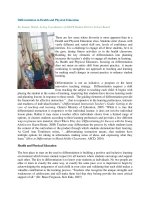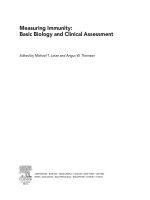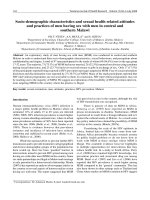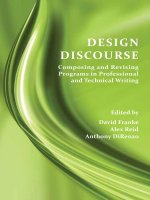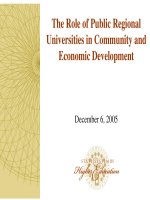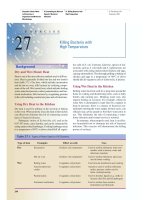Measuring Innovation in OECD and NON-OECD Countries doc
Bạn đang xem bản rút gọn của tài liệu. Xem và tải ngay bản đầy đủ của tài liệu tại đây (415.04 KB, 26 trang )
Free download from www.hsrcpress.ac.za
Free download from www.hsrcpress.ac.za
Free download from www.hsrcpress.ac.za
PreparedfortheDepartmentofScienceandTechnologyandtheOrganisationforEconomicCo-operation
andDevelopment(OECD)bytheCentreforScience,TechnologyandInnovationIndicators(CeSTII)inthe
KnowledgeSystemsProgrammeoftheHumanSciencesResearchCouncil
PublishedonbehalfoftheDepartmentofScienceandTechnology.
PublishedbyarrangementwiththeOECD.Theopinionsexpressedandargumentsemployedhereindonot
necessarilyreflecttheofficialviewsoftheOrganisationorofthegovernmentsofitsmembercountries.
PublishedbyHSRCPress
PrivateBagX9182,CapeTown,8000,SouthAfrica
www.hsrcpress.ac.za
©2006HumanSciencesResearchCouncil
Firstpublished2006
Allrightsreserved.Nopartofthisbookmaybereprintedorreproducedorutilisedin
anyformorbyanyelectronic,mechanical,orothermeans,includingphotocopying
andrecording,orinanyinformationstorageorretrievalsystem,withoutpermission
inwritingfromthepublishers.
ISBN0-7969-2062-1
CopyeditedbyRobynArnold
TypesetbyRobinTaylor
CoverbyFarmDesign
PrintmanagementbycomPress
DistributedinAfricabyBlueWeaver
SpecialistPublishersRepresentatives
POBox30370,Tokai,CapeTown,7966,SouthAfrica
Tel:+27(0)21701-4477
Fax:+27(0)21701-7302
email:
www.oneworldbooks.com
DistributedinEuropeandtheUnitedKingdombyEurospanDistributionServices(EDS)
3HenriettaStreet,CoventGarden,London,WC2E8LU,UnitedKingdom
Tel:+44(0)2072400856
Fax:+44(0)2073790609
email:
www.eurospanonline.com
DistributedinNorthAmericabyIndependentPublishersGroup(IPG)
OrderDepartment,814NorthFranklinStreet,Chicago,IL60610,USA
Calltoll-free:(800)8884741
Allotherenquiries:+1(312)3370747
Fax:+1(312)3375985
email:
www.ipgbook.com
Free download from www.hsrcpress.ac.za
Contents
Listoftables vii
Listoffigures x
Foreword xiii
Acknowledgements xv
Abbreviationsandacronyms xvii
IntroductionMarioScerri 1
Part1 Theoreticalfoundationsofinnovationsurveys
Chapter1 Theconceptualfluidityofnationalinnovationsystems:Implicationsfor
innovationmeasures 9
MarioScerri
Chapter2 Innovationsystemsinemerginganddevelopingeconomies 21
Jean-EricAubert
Chapter3 Developingthelinkagebetweenpolicyandinnovationmeasurement 43
BrianSloan
Chapter4 Countingtheseedsofinnovation:Theassessmentoftechnological
creativity 59
ChristiaanRedelinghuys
Chapter5 Mappingandmeasuring:Aholisticapproachtoauditinginnovation 73
VictorRoss&AntonKleingeld
Chapter6 Macroeconomicmeasuresforthereturnoninvestmentininnovation 83
DavidWalwyn
Part2 Approachestomeasuringinnovationinregionsandcountries
Chapter7 Innovationsurveys:LessonsfromtheexperiencesofOECDcountries 93
DominiqueGuellec&BillPattinson
Chapter8 UsingtheOslomethodologytomeasureinnovation:TheCommunity
InnovationSurveyapproach 111
FrankFoyn
Chapter9 Closingthegapsinsystemsofinnovationresearch:Howtoimprovethe
measurementofinnovationfinancebytheCommunityInnovation
Surveys 123
IlianPetkovIliev
Chapter10 AnoverviewofLatinAmericaninnovationsurveys 141
GuillermoAnlló
Chapter11 TheBogotáManual:StandardisinginnovationindicatorsforLatinAmerica
andtheCaribbean 163
GustavoLugones
Chapter12 Innovationindicatorswithinsub-SaharanAfrica:Aspecificcasefor
Tanzania 183
BitrinaDiyamett&SamuelWangwe
Free download from www.hsrcpress.ac.za
Chapter13 InnovationsurveysinCentralandEasternEurope:Resultsandpolicy
issues 199
SlavoRadosevic
Chapter14 SouthAfrica’sfirstsurveyofinnovationinthemanufacturingsectorand
recommendationsforthenextsurvey 217
WilliamBlankley&DavidKaplan
Chapter15 ResearchdesignfortheSouthAfricanInnovationSurvey2001 227
LeonOerlemans,AndréBuys&MarthinusPretorius
Chapter16 Estimatingdisparities,complementaritiesandgapsbetweenregionsand
countries:ThecaseofChinaanditsprovincesin1993 251
ChrisdeBresson,XuShiqing&PierreMohnen
Part3 Approachestomeasuringinnovationinsectors
Chapter17 Keydriversintechnologicallyexcellentorganisations:Asuiteofindicators,
trendsandinterpretations 281
RoyMarcus&JanieBasson
Chapter18 UnderstandingtechnologyandeconomicdevelopmentinSouthAfrican
industry:Thecaseoftheplasticssector 297
SimonRoberts
Chapter19 AttemptstosurveyinnovationintheHungarianservicesector 309
AnnamáriaInzelt
Listofcontributors 329
Free download from www.hsrcpress.ac.za
vii
List of tables
Table2.1 SubcategoriesofdevelopingcountriesbyS&Tcapacity 22
TableA2.1 Countriesselectedfortheknowledgeassessmentscorecards 34
TableA2.2 Variablesusedinthe‘standard’15-variablescorecards 36
TableA2.3 Othervariablesavailableintheknowledgeassessmentmethodology
exercise 36
TableA2.4 Dataforvariablescorrespondingtoinnovationclimate 40
Table3.1 Someexamplesoftheuseofinnovationsurveydata 46
Table3.2 Environmentalinnovationindicatorsincludedinthefamilyofinnovation
surveysbasedontheOsloManual 50
Table5.1 Theinfluenceofthebusinesscontextontypicalorganisationalattributes 75
Table6.1 R&Dspendingbyindustryfor2000(USAonly) 84
Table7.1 InnovationratesforEUcountriesbyindustry(1994–1996) 95
Table7.2 InnovationratesforEUcountriesbysizeoffirm(1994–1996) 96
Table7.3 Technologicalandnon-technologicalinnovationinAustralia(1993–1994) 97
Table7.4 TechnologicalinnovationinEUcountries(1994–1996) 98
Table7.5 Shareofinnovativeproductsalesinturnover(manufacturing) 100
Table7.6 GrowthinsalesintheNetherlands(1994–1996) 103
Table7.7 FirmproductivityandprofitabilityinAustralia(1993–1994) 103
Table7.8 ImpactofinnovationonproductionactivitiesinAustralia(1996–1997) 104
Table7.9 GrowthinemploymentintheNetherlands(1994–1996) 105
Table7.10 ProportionoffirmsincreasingemploymentinAustralia 106
Table10.1 ComparisonofCIS-2andCIS-3questionnaires 153
TableA10.1 Generalcharacteristicsofthesurveys 157
TableA10.2 Comparisonofthealternativeswithrespectto‘economicobjectivesof
innovation’ 158
TableA10.3 Comparisonofthealternativeswithrespectto‘sourcesofinformationfor
innovation’ 159
TableA10.4 Comparisonofthealternativeswithrespectto‘factorshamperinginnovation
activities’ 160
TableA10.5 OrganisationalcharacterisationofR&D 161
TableA10.6 Comparisonamongthealternativesof‘innovationexpenditures’ 161
TableA10.7 Commonbodyofissuesforcomparison 161
Free download from www.hsrcpress.ac.za
M E A S U R I N G I N N O V AT I O N I N O E C D A N D N O N - O E C D C O U N T R I E S
viii
Table12.1 SelectedmacroeconomicindicatorsforTanzania 187
Table12.2 Povertyindicators:comparisonbetweenTanzaniaandaveragesfordeveloping
anddevelopedcountries 188
Table13.1 SharesofinnovativefirmsinEUandCentralandEasternEurope 208
Table13.2 Shareofinnovativeenterprisesbysizeofenterprise(1996–1997) 210
Table13.3 Innovationexpenditureinmanufacturingsectorbyeconomicactivity
(1996–1997) 211
Table15.1 Simplerandomsamplesizefordifferentdegreesofprecisionforapopulation
of16931 237
Table15.2 Stratumsize,mean,standarddeviationandvariance 240
Table15.3 SamplesizeforSAIS2001 242
Table15.4 CompositionoftheSAIS2001questionnaire 243
Table16.1 Provincialinnovativespecialisations 260
Table16.2 China’spropensitytoinnovate,1993:largeandmedium-sizedindustrial
enterprises 267
Table16.3 ThepropensitytoinnovateofindustrialenterprisesinEurope(includingsmall
firms) 268
Table16.4 Observedandpredictedproportionofinnovativefirmsandproportionof
innovativesalesintheemergingphaseoftheproductlifecyclebyregionsand
provinces(%) 271
Table16.5 Propensitytoinnovate:shareofinnovativesalesintheemergingphaseofthe
productlifecyclebyindustry 272
Table16.6 Observedandpredictedproportionofinnovativefirmsandproportion
ofinnovativesalesintheemergingandgrowthphaseoftheproduct
lifecycle(%) 273
Table16.7 Propensitytoinnovate:shareofinnovativesalesintheemergingandgrowth
stagesoftheproductlifecyclebyindustry 274
Table16.8 Empiricallyplausiblecausalexplanationsforinnovativeperformance(plausible
explanatoryvariables) 274
Table18.1 Internationalisationandproductionchange 303
Table18.2 Firmgrowth,productiontechniquechangesandinternationaltrade 304
Table19.1 ThelifelinesoftheHungarianinnovationfeasibilitysurvey(service
sector) 312
Table19
.2 ComparingtheHungarianinnovationsurveyquestionnairetoCIS-2
(servicesector) 313
Table19.3 Numberoforganisationsbyeconomicsectorandbyinnovation 314
Table19.4 Themostimportantaimsstimulatinginnovation(1996–1998) 315
Table19.5 Theimportanceofinformationsourcesforinnovationbyeconomic
sector 315
Free download from www.hsrcpress.ac.za
ix
Table19.6 Theimportanceofsourcesofinformationbytheirfieldofapplication 316
Table19.7 NumbersandproportionofthoseengagedinR&D 318
Table19.8 Rankingofinnovativeactivitiesbyresourcesallocated(1998) 319
Table19.9 ThefrequencyofR&Dactivity(1996–1998) 320
Table19.10 Rankingofmethodstoprotectcompetitiveadvantage 320
Table19.11 Numberandtypeof‘partnerorganisations’ofrespondingcompanies
participatingininnovationcooperation(1996–1998) 321
Table19.12 Organisationalchangesaffectingturnover(1996–1999) 322
Table19.13 Theeffectsoffactorshinderinginnovation(1996–1998) 323
L I S T O F T A B L E S
Free download from www.hsrcpress.ac.za
x
List of figures
Figure2.1 Bargraphoftheentrepreneurshipvariablecorrespondingtoinnovation
climate 24
Figure2.2 Bargraphoftheventurecapitalvariablecorrespondingtoinnovation
climate 24
Figure2.3 Bargraphoftheresearchcollaborationvariablecorrespondingtoinnovation
climate 24
Figure2.4 Bargraphofthelocalcompetitionvariablecorrespondingtoinnovation
climate 25
Figure2.5 Bargraphofthetariffandnon-tariffbarriersvariablecorrespondingto
innovationclimate 25
Figure2.6 Bargraphoftheregulatoryframeworkvariablecorrespondingtoinnovation
climate 25
Figure2.7 Bargraphofthegovernmenteffectivenessvariablecorrespondingto
innovationclimate 26
Figure2.8 BargraphoftheFDIasapercentageofGDP(1990–1998)variable
correspondingtoinnovationclimate 26
Figure2.9 Worldregionswithall61variablesselected 27
Figure2.10 Innovationsystemsofselectedlargeeconomies:Brazil,China,India 29
Figure2.11 TotalR&Dexpenditure,(PPP1996)asapercentageofGNPand
scientistsandengineerspermillion 30
FigureA2.1 StandardscorecardsofSouthAfrica:comparisonrelativetoallcountriesand
relativetoAfrica 38
FigureA2.2 InnovationsystemsofJapan,RussiaandtheUnitedStates 39
Figure4.1 Resource–effort–valuenomogram 64
Figure4.2 Relativecreativeperformance 64
Figure4.3 Growthinaircraftcruisingspeed 66
Figure4.4 Designqualitystatus 66
Figure4.5 Classesofengineeringdesignknowledge 68
Figure5.1 Thecircleofinnovation 74
Figure5.2 Aconceptualmapofinnovation 77
Figure5.3 ResultsofaninnovationauditofanR&Ddepartment 79
Figure6.1 Wasteddevelopmentspendingcomparedwithcommercialisationsuccessfor
variousindustries 84
Free download from www.hsrcpress.ac.za
xi
Figure6.2 Comparisonofbest-in-classcompanieswithaveragecompaniesinderivinga
returnfromtheirR&Dinvestment 86
Figure6.3 Exponentialprojectexpenditureastheproductnearscommercialisation 87
Figure6.4 Projectmortalityatvariousstages 87
Figure13.1 Innovationexpenditureasashareoftotalturnover 202
Figure13.2 InnovationintensityversusshareofR&Dininnovationexpenditureon
manufacturing 203
Figure13.3 Innovationintensityversuspercentageofinnovatorsinmanufacturing
(1996) 203
Figure13.4 AnalyticalframeworkforinterpretingUSforeignpatentdatafor‘catching-up’
economies 204
Figure15.1 Researchmodel 234
Figure15.2 Operationalisationoftheresearchmodel 248
Figure16.1 InnovativeactivitiesofGuangdongprovince(1993) 256
Figure16.2 InnovativeactivitiesofJiangxi(1993) 256
Figure16.3 InnovativeactivitiesinChina(1993) 258
Figure16.4 NumberofemployeesinEuropestem-and-leafplot 262
Figure16.5 TurnoverinthousandsofECUinEuropestem-and-leafplot 263
Figure16.6 NumberofemployeesinChinastem-and-leafplot 263
Figure16.7 TurnoverinthousandsofRMBinChinastem-and-leafplot 264
Figure16.8 InnovationinvestmentexpenditureperemployeeinChinaandEurope(1993)
(atanexchangerateof1ECU=5RMB) 265
Figure16.9 InnovationinvestmentexpenditureperemployeeinChinaandEurope(1993)
(atanexchangerateof1ECU=1.6RMB) 266
Figure17.1 Contextualframeworkforadjudication 282
Figure17.2 OrganisationtypeofTechnologyTop100organisations 287
Figure17.3 Percentagetechnicalgraduatesinthetoptwotiersoftheorganisations’
decision-makingstructures 287
Figure17.4 Percentagerevenuegeneratedfromproducts0–3yearsold 288
Figure17.5 Percentageproductinnovationsdevelopedentirelyin-house 289
Figure17.6 Percentageproductinnovationsthroughalliances/jointventureswith
internationalparties 290
Figure17.7 Percentagerevenuegeneratedfromexportsalesoverthepastthreeyears 290
Figure17.8 R&Dexpenditureasapercentageofturnover 291
Figure17.9 Timereductioninmanufacturingperproductoverthepastthreeyears 292
Figure17.10 Averageageofmanufacturingequipment 292
Free download from www.hsrcpress.ac.za
M E A S U R I N G I N N O V AT I O N I N O E C D A N D N O N - O E C D C O U N T R I E S
xii
Figure17.11 Percentageofnewproductdevelopmentssuccessfullycommercialisedoverthe
pastthreeyears 294
Figure17.12 Averageleadtimetakenfromprototypedevelopmenttofull
commercialisation 294
Figure18.1 Sourcesofnewtechnologies 303
Figure18.2 Importanceofdifferentfactorsfornewinvestmentsand/orproduction
techniques 303
Free download from www.hsrcpress.ac.za
xiii
Foreword
ThroughtheDepartmentofScienceandTechnology(DST),SouthAfricahashadthebenefit
ofobservermembershipontheOECD’sCommitteeforScientificandTechnologicalPolicy
(CSTP)since1998.ThisallowsSouthAfricatoparticipateintheGlobalScienceForum
(GSF),WorkingGrouponTechnologyandInnovationPolicy(TIP),NationalExpertson
ScienceandTechnologyIndicators(NESTI)andtheWorkingPartyonBiotechnology
(WPB).
TheworkofNESTI,particularlyintheareasofResearchandExperimentalDevelopment
(R&D)andInnovationSurveys,hasbeenofspecialinteresttotheDepartmentandledto
theOECDandSouthAfricahostingajointseminaronthemeasurementofinnovation
activitiesinOECDandnon-OECDcountriesinPretoriainMarch2001.Theseminarwas
wellattended,with132delegatesfromOECDcountriesandotherregionsoftheworld
(Africa,LatinAmericaandAsia)participatinginaveryfruitfulexchangeofexperiences.
TheimportanceofregularmeasurementofbothR&Dandinnovationthroughproper
nationalsurveyswasbroughtintofocusforSouthAfricaattheseminar.Iwouldliketotake
thisopportunitytosincerelythanktheSteeringCommitteeandtheteamfromtheOECD
Secretariatfortheirhardworkinensuringthattheseminarwasasuccess.
Iampleasedtoreportthatsincetheseminar,SouthAfricahasmaderapidprogress
inestablishingareliable,nationallyandinternationallyacceptedsetofofficialscience
andtechnologystatistics.Thesestatisticsinturnprovidethemainindicatorsrequired
tounderpintheimplementationofSouthAfrica’snationalR&DStrategyasoutlined
bygovernment.In2002,theCentreforScience,TechnologyandInnovationIndicators
(CeSTII)oftheHumanSciencesResearchCouncilwascommissionedbyDSTtoundertake
aregularseriesofR&DandInnovationSurveysinordertoestablishabaselineofofficial
S&Tindicators.InJune2004,theDSTandStatisticsSouthAfricasignedaMemorandumof
Agreementconcerningtherecognitionofofficialnationalscienceandtechnologystatistics.
ThisbookthusrecordsanimportanthistoricalturningpointinSouthAfrica’sprogress
towardsaneffectivenationalsystemofinnovation.Theseminarbroughttotheforesomeof
thekeycriticaldifferencesbetweendevelopedanddevelopingcountriesintheirapproaches
tomeasuringinnovation.Thesedifferencesareclearlyreflectedinthevariouschapters
ofthisbook,whichcoversomeofthemostimportantdebatesthatemergedduringthe
seminar.
RobAdam
Director-General
DepartmentofScienceandTechnology
SouthAfrica
Free download from www.hsrcpress.ac.za
Free download from www.hsrcpress.ac.za
xv
Acknowledgements
TheeditorswishtothanktheSouthAfricanSteeringCommitteefortheseminar(Johann
Mouton,CalliePistorius,BonganiNkosi,KrishPillayandDaveKaplan),ledbyImraan
SaloojeeandmanagedbyMarjoriePyoos.ThanksarealsoduetotheteamfromtheOECD
Secretariat,AndrewWyckof,JeanGuinet,LaudelineAuriolandDominiqueGuellec,who
providedvaluableassistancetotheDepartmentandtheSteeringCommitteeinorganising
theseminar.Inparticular,wewouldliketoexpressourgratitudetotheSteeringCommittee
forundertakingthetaskofpeer-reviewingandselectingpapersfortheseminar,andtoRob
Adam,Director-GeneraloftheDST,whoprovidedtheopeningaddressaswellasArno
Webb,whochairedtheopeningsession.
Sometimehaselapsedsincetheseminartookplaceandforvariousreasonsthepublication
oftheproceedingsfromtheseminarwasdelayed.Whenthisprocesswasrevivedin2004,
somepresentationswereincompleteornotyetreadyforpublication.Regrettably,wealso
foundthatsomeauthorswerenotcontactabledespiteextensivesearchesandenquiries,
whileotherauthorshadtowithdrawtheirpapersbecausetheyhadbeenpublished
elsewhere.Nonetheless,webelievethatthepapersinthisvolumerepresentaselectionofthe
mostcogentpaperspresentedattheseminar.
Theeditorswouldliketothankalltheauthorswhodidsubmitpapersforpublication,and
tookthetimetoupdateandimprovethemandmeetthedeadlinesoftheeditorialprocess.
SpecialthanksareduetoRobynArnoldofWriteConnectionforherexcellenteditingskills
andIngaNoreniusofHSRCPresswhomanagedthepublicationprocessandthedesignand
layoutofthebook.
Free download from www.hsrcpress.ac.za
Free download from www.hsrcpress.ac.za
xvii
Abbreviations and acronyms
ABS AustralianBureauofStatistics
BIC Best-in-class
CARMATEC CentreforAgriculturalMechanisationandRuralTechnology
CBS CentralBureauofStatistics
CEIES EuropeanAdvisoryCommitteeonStatisticalInformationintheEconomic
andSocialSpheres
CIS CommunityInnovationSurvey
CMEA CouncilforMutualEconomicAssistance
COMECON CouncilforMutualEconomicAssistance
COSTECH TanzaniaCommissionforScienceandTechnology
CPI Consumerpriceindex
CV Coefficientofvariation
CYTD LatinAmericanProgrammefortheDevelopmentofScienceand
Technology
DACST DepartmentofArts,Culture,ScienceandTechnology(SouthAfrica)
DISKO DanishInnovationSysteminKOmparativeperspective
DTI DepartmentofTradeandIndustry
EBRD EuropeanBankforReconstructionandDevelopment
EC EuropeanCommission
ECU EuropeanCurrencyUnit
EEA EuropeanEconomicArea
ERP EconomicRecoveryProgramme
ESRF EconomicandSocialResearchFoundation
EU EuropeanUnion
FDI Foreigndirectinvestment
FRD FoundationforResearchDevelopment
GATT GeneralAgreementonTariffsandTrade
GDP Grossdomesticproduct
GERD GrossnationalexpenditureonR&D
GNP Grossnationalproduct
HCSO HungarianCentralStatisticalOffice
Free download from www.hsrcpress.ac.za
M E A S U R I N G I N N O V AT I O N I N O E C D A N D N O N - O E C D C O U N T R I E S
xviii
HDI Humandevelopmentindex
ICRG Internationalcountryriskguide
ICT Informationandcommunicationtechnology
IKU InnovationResearchCentre,Budapest
IMR Infantmortalityrate
IOI InventoryofOrganisationalInnovativeness
IPAR InstituteofPersonalityAssessmentandResearch
ISIC InternationalStandardIndustrialClassification
ISP IndustrialStrategyProject
M&A Mergerandacquisition
MBTI-CI Myers-BriggsTypeIndicatorCreativityIndex
MCC-PED Multi-countryComparativeStudyofPrivateEnterprisesDevelopment
MERIT MaastrichtEconomicResearchInstituteonInnovationandTechnology
MMR Maternalmortalityrate
MNC Multinationalcorporation
MSTI MainScienceandTechnologyIndicators
NACE GeneralIndustrialClassificationofEconomicActivitieswithinthe
EuropeanCommunities
n.a. Notapplicable
nec. Notelsewhereclassified
NESTI NationalExpertsonScienceandTechnologyIndicators
NIS Nationalinnovationsystem
NPD Newproductdevelopment
OAS OrganisationofAmericanStates
OECD OrganisationforEconomicCo-operationandDevelopment
OMFB NationalCommitteeofTechnologicalDevelopment,Hungary
PFSA PlasticsFederationofSouthAfrica
PME Performancemonitoringandevaluation
PPP Purchasingpowerparity
PRSP PovertyReductionStrategyPaper
R&D Researchandexperimentaldevelopment
RCAP RiskCapitalActionPlan
RDEI Researchanddevelopmenteffectivenessindex
REV Resources,effort,value
Free download from www.hsrcpress.ac.za
xix
RICYT Ibero-AmericanNetworkofScienceandTechnologyIndicators
RMB Renminbi(‘People’sCurrency’,China)
ROII Returnsoninnovativeinvestments
RTD Researchandtechnologicaldevelopment
SADC SouthernAfricanDevelopmentCommunity
SAIS SouthAfricanInnovationSurvey
S&T Scienceandtechnology
SBIR SmallBusinessInnovationResearchProgramme
SESSI ServicedesÉtudesetStatistiquesIndustrielles
SISAMF SurveyofInnovationinSouthAfricanManufacturingFirms
SME Smallandmediumenterprises
SOE State-ownedenterprise
SSB StateStatisticalBureau(China)
TBP Technologybalanceofpayment
TEMDO TanzaniaEngineeringandManufacturingDesignOrganisation
THRIP TechnologyandHumanResourcesforIndustryProgramme
TIRDO TanzaniaIndustrialResearchDevelopmentOrganisation
TPP Technologicalproductandprocess
TRIZ TheoryofSolvingInventiveProblems
UK UnitedKingdom
UNESCO UnitedNationsEducational,ScientificandCulturalOrganisation
UNIDO UnitedNationsIndustrialDevelopmentOrganisation
UNU/INTECH UnitedNationsUniversityInstituteofTechnology
URT UnitedRepublicofTanzania
US/USA UnitedStates/UnitedStatesofAmerica
WIPO WorldIntellectualPropertyOrganisation
WTO WorldTradeOrganisation
Free download from www.hsrcpress.ac.za
Free download from www.hsrcpress.ac.za
1
Introduction
Mario Scerri
Statisticshashelpeddeterminetheformoflawsaboutsocietyandthecharacterof
socialfacts.Ithasengenderedconceptsandclassificationswithinthehumansci-
ences.Moreoverthecollectionofstatisticshascreated,attheleast,agreatbureau-
craticmachinery.Itmaythinkofitselfasprovidingonlyinformation,butitis
itselfpartofthetechnologyofpowerinthemodernstate.(Hacking1991:181)
ThisbookemergedfromtheseminarontheMeasurementofInnovationActivitiesin
OrganisationforEconomicCo-operationandDevelopment(OECD)andnon-OECD
countriesthatwasheldinSouthAfricain2001.Themotivationforthatforumwasthe
recognisedneedtoaddressanewandexcitingphenomenonintheareaofeconomic
policyformulation.Thelandmarksofthisphenomenonwerethepublicationofthe1992
OsloManualandthenewEurostatCommunityInnovationSurvey(CIS).Theseevents
markedanotableruptureintheplacementofinnovationwithinmacroeconomicpolicy
formulation.Thisruptureresultedinashiftofinnovationtheory(offering,asitdoes,what
maywellbeoneofthemoreformidablechallengestotheneoclassicalaccountofeconomic
growth)fromtherealmsofatheoreticaldebatetopraxis.Inaway,theparadigmshiftthat
hadoccurredintheory,withtheemergenceofevolutionaryeconomicsandinnovation
theory,nowbecamemanifestinacorrespondingshiftinthenatureofthestatisticaltoolof
(political)economicgovernance.
Innovationtheoryhad‘arrived’,anditslegitimacywasfurtherratifiedinalaterOECD
document(OECD1997)thatexplicitlyarticulatedthetheoreticalfoundationofthis
newtypeofsurvey,whichhadgonefarbeyondthepreviousdatagatheringonresearch
anddevelopmentinOECDmembercountries.Therupturemarkedadeparturefrom
aneconomicplanningframeworkwhereinthescienceandtechnology(S&T)sectorwas
incorporatedintheorthodoxneoclassicalmodeltoaninnovationtheory-basedapproach
togrowththatfundamentallychallengesthismodel.Itredirectedtheanalysisoftherole
oftechnology,andofinnovationingeneral,inthegrowthofnations,awayfromresidual
analysistothemainstream.Thisrupturethusarosefromtwolinkeddevelopments.Thefirst
wastheincreasinglyapparentimportanceofinnovationinthegrowthanddevelopment
ofeconomies,especiallyinthelatterpartofthetwentiethcentury.Thesecondwasthe
realisationthattheessentiallystaticanalyticalframeworkofmainstreamneoclassicaltheory
wasillsuitedfortheanalysisoftheeconomicroleofinnovation.Thesetwodevelopments
providedwhatonemaycallthepoliticalbasis,themotiveforce,fortheemergenceofthe
newsurvey.
Thedevelopmentofanewsurvey,seekingnewdataandnewwaysoforganising
information,isnolightmatter,andthesignificanceofanewsurveyisobviouslymost
pronouncedwhenitreflectsashiftinthetheoreticalbase,inthiscasefromneoclassicalto
evolutionarytheory.Thescopeofsurveysthatareadoptedbygovernmentsisanchoredin
governance,andthedevelopmentofsuchsurveysisthusfundamentallydifferentfromthe
normalprocessofacademicenquiry.Thereisalwaysaninevitablereciprocalrelationship
betweentheobjectofenquiryandthemodeofenquiry,butinthecaseofofficialsurveys,
Free download from www.hsrcpress.ac.za
M E A S U R I N G I N N O V AT I O N I N O E C D A N D N O N - O E C D C O U N T R I E S
2
especiallythosethatarestandardisedforgroupingsofcountries,thisrelationshiptends
tosetearly.Inanewtypeofsurveythatemergesfromashiftintheoreticalfoundations,
thisreciprocityisacoreareaofconcern,sinceitsetstheformandtheparametersfor
futurediscourse.Herewemayusetheanalogyoflock-intechnologiesandcumulative
pathdependencytocautionagainstthetoorapidadoptionofasetmodeofenquiry.At
thisinitialstageoftheemergenceofthenewsurvey,thefirstfocusisonthechoiceof
informationthatisrequiredandthedatathatwillbegatheredtocapturesuchinformation.
Theissuesofinclusionandexclusionthatariseatthisstageshouldproceedfromaclear
statementoftheobjectofenquiry.However,apristinearticulationisoftendifficult
intheperiodofparadigmatictransitions.Itispreciselyatthisearlystagethataclear
understandingoftheintentionalityofofficiallycompiledstatisticsisnecessary,bothfor
theanalystandforthepolicy-maker.Thestatementoftheobjectiveofthenewsurveyhas
tobeasexplicitaspossibleandbecontinuouslyre-examined.Theremustalsobeaclear
recognitionoftheconsequentandinevitabletrutheffectsofofficialstatistics.Withrepeated
applicationofagivensurveyform,thedefinitionoftheobjectofenquirybecomesfixed,
anditbecomesincreasinglyimprobablethatalternativeformswillemerge.
Thecriteriaforinclusionandexclusionarenumerous.Themostobviousoneisthe
technicalcriterionofquantifiability.Notallinformationcanbequantified,eventhough
surveydesignerscanbequiteingeniousintheconstructionofproxymeasuresofessentially
unquantifiableinformation.Anothersetofcriteriaisbasedonthetheoreticalunderpinning
ofthesurvey,anditisherethattherequirementofexplicitarticulationisstrongest.Such
articulationwouldsatisfytwocorepreconditionsfortheclearscientificapplicationof
surveystoresearchandpolicy.
Thefirstiswhatwemaycalltheclarityandpurityofthelanguageofanalysis.Thisstems
fromaclearunderstandingoftheparticularparadigmorschoolofthoughtwithinwhich
thespecificanalysisisset.Thisclarityisessentialifwearetoavoidamixingoflanguages
andtheconsequentunresolvableconfusionofinduction.Certainly,suchclarityismore
difficultintheshiftfromonetheoreticalbasetoanother.Inevitablythereisalanguagebind,
asetofresiduesfromapreviouslanguageofanalysistothenewone.Inthespecificcaseof
innovationsurveys,itisthelanguageofneoclassicaltheorywhosetracesinevitablypersist.
Thesecondpreconditionisthespecificationofthecontextualdemandsonsurveys.The
differentiatingcriterionamongcontextsisusuallythestageofeconomicdevelopment.It
isthereforeparticularlysignificantthattheseminaronwhichthisbookisbasedsetsout
specificallytoexaminetherelevanceofanestablishedsurvey,developedwithintheglobal
economiccore,toeconomiesatdifferentstagesofdevelopment.Itwouldbenaive,however,
especiallywithrespecttotherichnessoftheanalysisofinnovationsystems,touseavague
conceptof‘thestageofeconomicdevelopment’asthedifferentiatingprincipleamong
applications.Innovationtheorycertainlycautionsagainsttheglibadoptionofapparently
self-evidentorganisingtaxonomies.Therearenumerousdeterminantsofthesignificant
differencesamonginnovationsystems,andthemajorcornerstoneofinnovationtheoryis
thecomplexspecificityofsystemsandthetensionbetweenspecificityandcommonality.
Eventhoughtheunderlyingtheoryiscommon,contextmayverywellaffecttheshapeand
theconsequentutilityofthesurvey.
Thereis,ofcourse,nosinglepointoreventthatmarksashifttopraxissuchastheseminar
thatisthefocusofthisvolume.Rather,thereisaprocessthroughwhichtheshiftdevelops
andestablishesaneworder.TheOsloManualandtheEurostatCISwere,sotospeak,the
launchingpadsfortheprocess,andtheworkscontainedinthisvolumearepartofthat
Free download from www.hsrcpress.ac.za
I N T R O D U C T I O N
3
process.Thecontributionsinthisbookcertainlyofferwidecoverageoftheissuesandthe
potentialproblemsandpitfallsoftheemergingsurveysoninnovation.Intheprocess,they
setthescopeforanexcitingagendaforfutureresearchonthevariousaspectsofinnovation
surveys.Theyrangefromthepurelytheoreticalexplorationofthefoundationofinnovation
surveystonumerousexpositionsofalternativeinnovationsurveystructuresinavariety
ofdevelopmentcontexts.Anyclassificationsystemisperforcearbitraryandimperfect,
andthisisalsotrueofthesectionswithinwhichthevariouscontributionsinthisbook
havebeenplaced.Thesectionsareuseful,however,inprovidingastructurewithinwhich
thecontributionsmaybeplacedinrelationshiptooneanotherandtotheissuesthatthey
address.
Thecontributionsinthisvolumehavebeenplacedinthreebroadsections.Thoughthe
areasthatareaddressedthroughoutthebookobviouslyoverlapsubstantially,thegrouping
ofthevariouschaptersoffersaprogressionfromamoretheoreticalapproachtotheissue
ofwhatwemaycallthelocalisationofinnovationsurveysinanalysesthatbecomespecific
toregion,country,industryand,finally,organisation.Again,thereisaloosetransitionfrom
theorytopraxisinthisbookthatmirrorstheemergenceofinnovationsurveysfromthe
theoryoftheeconomicsofinnovation;but,takentogether,thisbodyofworkismorethan
that.Initscoverageofthegamutofthetheoretical,methodologicalandeventhepractical
implicationsofinnovationsurveys,itprovidesareferencesetforanumberofinterlocking
debatesinthisarea.Itsetstheframeworkfortheemergingdiscourseoninnovationsurveys,
theiranchorage,thelimitationsoftheirvariousspecificitiesandthepossibilitiesfortheir
evolution.
Thefirstsectionlooksatthetheoreticalfoundationsonwhichinnovationsurveysare
constructed.Thesixcontributionsinthissectionintroducetherelationshipbetweentheory
andtheconsequentempiricalmethodologycontainedininnovationsurveys.Ifthereis
oneprimeunderlyingconcerninthisrelationship,itwouldbethatofthe‘unsaid’–the
omissionsandthenon-explicitassumptionsofsurveymethodology.Itisinthistenebrous
areathattheclarityoftheemergenceofanewempiricaltoolderivedfromanewbody
oftheorycanbetested.Fromthisperspective,Scerrilooksattheimplicitassumptions
ofsurveysdesignedforindustrialisedeconomiesandtheirimplicationsforalternative
applications.Aubertpresentsaspecificassessmentoftherelevanceofstructuraldifferences
ininnovationsystems,especiallybetween(economically)developinganddevelopedregions
intheworld,tothedesignofinnovationsurveys.ThechapterbySloanaddressesdirectly
thematteroftheutilityofinnovationsurveysforthepolicy-maker.Itcoversarangeof
studiesonthetwo-wayrelationshipbetweeninnovationsurveysandpolicyformulation.
Inthisanalysis,surveymethodologyitselfisassessedasaninnovationprocessthatis
non-linear,thatevolveswithinitspolicyformulationenvironment,andthatcanoften
besignificantlycontextspecific.Redelinghuyslooksatthedefinitionsofinnovationand
itsmeasurability,primarilyfromanengineeringperspective,andproposesconsequent
extensionstothesurveycoverage.ThecontributionbyRoss&Kleingeldconsidersthesame
phenomenonfromanorganisationalperspective.Althoughtheempiricalpartoftheworkis
basedonaspecificcase,theimplicationsfortheexpansionofinnovationindicatorstocover
organisational‘enablers’certainlyinvolvesgeneralmethodologicalissues.Walwynextends
thereachofinnovationsurveystoassessthereturnsoninnovationexpendituresfroma
commercialperspective.Thishelpstoamplifytherangeofcriteriausedbypolicy-makersto
allocatepriorities.
Thesecondsectionexaminesthemethodologicalimplicationsthatareraisedbythe
empiricalapplicationofinnovationsurveysinvariouscountriesandregions.Allthe
Free download from www.hsrcpress.ac.za
M E A S U R I N G I N N O V AT I O N I N O E C D A N D N O N - O E C D C O U N T R I E S
4
contributionslookatspecificinnovationsurveys,startingfromtheOsloManual,inorderto
examinetheconsequencestothecoreofinnovationsurveysofexpandingtheoriginalsurvey
formattoaccommodateregionalandotherspecificities.Thebasisissetoutintheexposition
oftheEurostatsurveyinGuellec&Pattinson,andinFoyn,providingthepointofreference
forthemethodologicalextensionsproposedfromtheperspectivesofspecificregional
requirements.FoynprovidesadetailedtourthroughtheevolutionoftheCommunity
InnovationSurveyfromCIS-1toCIS-3.Intheprocess,heprovidesaframeworkwithin
whichthemainmethodologicalissuesmaybeidentifiedandlocated.GuellecandPattinson
gointothesurveyfindingsforspecificOECDcountriesandintheprocesstheyhighlight
thecoreissuesoftheintentionsoftheCIS,thecomparabilityofitsresultsacrossOECD
membercountriesanditsmethodologicalshortcomings.Ilievopensuptherelativelylittle-
exploredareaofinnovationfinance,whichisradicallydistinctfromfinancingothertypesof
investment.Consequently,theincidenceandthenatureoftheinstitutionalbottlenecksinthe
flowoffinanceforinnovationactivityaresubstantial,variedandcertainlycontextspecific.
Thisshouldthereforebeaseriousareaforconcernwhendesigninginnovationsurveys.
Inthecaseofspecificregionalrequirements,thethreemainregionsthatareaddressedare
LatinAmerica(Anlló&Lugones),Africa(Diyamett&Wangwe)andCentralandEastern
Europe(Radosevic).Anllóshowsthatthenatureofinnovationthattakesplacesinspecific
countriesandregionscandirectlyandsignificantlyaffecttheappropriatenessofspecific
surveymethodologies.Inaveryclearmannerderivedfromaspecificempiricalcontext,this
paperarguesthatsurveydesignshouldbeprecededbyaclearunderstandingofthespecific
structureoftheinnovationsystemthatistobecovered.Anllóalsomakesastrongargument
forcoordinatedinnovationsurveysacrossinnovationsystemsthatsharecommoncore
characteristics.ThisrequirementisaddressedinLugones’sexpositionoftheBogotáManual,
whichprovidesthemodelforaninnovationsurveythatisindeedrelevanttoLatinAmerica,
whilepermittingcomparativeanalysisbothwithintheregionandwithotherregions.Ina
similarmanner,Diyamett&Wangweproposethatinnovationineconomieswithverylow
levelsoftechnologicalcapabilitieshastobedefineddifferentlyfrominnovationactivityin
technologicallyricheconomies.Theyshowthatmostofthemeasuresthatarecommonly
usedtocaptureinnovation,suchasformalresearchandexperimentaldevelopment(R&D)
investmentprogrammes,areinappropriatewhenappliedtoTanzaniaandsimilarcountries.
Instead,theemphasisofinnovationsurveysforsucheconomiesshouldbeonlearning
processes.Theargumentthatisadvancedimplicitlyisthatnotonlydoesthetheoretical
foundationhavetobeclearlyspecified,butthatthereshouldalsobeaclearunderstanding
oftheobjectoftheenquirybeforetheformoftheenquiryisdesigned.Inhisassessmentof
innovationsurveysinCentralandEasternEurope,Radosevicaddressesanumberofbroader
issues.Thefirstisthegeneralcaseofwhathecallsthe‘catching-up’economies(thatis,those
innovationsystemswherethebruntofinnovationactivityisdevotedtotheabsorption
ofnewtechnology,ratherthanitscreation).Healsoqueriestheimplicitassumption
oflinearityintherelationshipbetweenS&Tinputs,innovationandeconomicgrowth
underlyingcurrentinnovationsurveys,anassumptionthatisgenerallyboththeoretically
andempiricallyunfounded.Thegeneralcontributionofthesepapersistheinsightintothe
myriadproblemsofspecificationandinterpretation,aswellasthesheerlogisticalissues
involvedinconductingthesurveys.
Thissectionalsocontainsthreereportsoncountrysurveys.Twoofthereportsareon
surveysconductedinSouthAfrica(Blankley&KaplanandOerlemans,Buys&Pretorius)
whiletheother(DeBresson,Shiqing&Mohnen)offersacomprehensiveanalysisofthe
complexitiesinherentinsurveyingtheChineseinnovationsystem.Blankley&Kaplan
Free download from www.hsrcpress.ac.za
I N T R O D U C T I O N
5
reportonthefirstpilotsurveythatwascarriedoutforasectionoftheSouthAfrican
manufacturingsector.ThedesignofthepilotcloselyfollowedtheCISmodel,andthe
authorsmakerecommendationsforfuturefullsurveysfromthiswork.Thechapter
byOerlemansetal.providesthedesignofafully-fledgedsurveyoftheSouthAfrican
innovationsystemthatwasabouttobeundertaken.ItscoredesignfollowstheCISmodel,
butsomevariationsareproposedtoallowforthespecificitiesoftheSouthAfricancontext.
DeBressonetal.lookatthevastandcomplexinnovationsystemofChina,asysteminthe
processofradicalstructuraltransformation,andprovideasurveyframeworkwithinwhich
thissystemcannotonlybeassessedbutalsobeopenedupforcomparativeanalysis.
Thethreecontributionsinthethirdsectionfallintotwocategoriesandservetoidentify
twofurtherdimensionsofspecificitythatarepossibleinthedesignandapplication
ofinnovationsurveys.Thefirstcategorystudiesparticulartypesoffirms,specifically
technology-intensiveorganisations.Thechapterinthiscategorylooksatthespecificsetsof
characteristicsofhightechnologyorganisations(Marcus&Basson).Theextensionofthe
implicationsofthispapertothewiderangeofspecificsectorsinspecificeconomiesoffers
almostoverwhelmingpossibilitiesforextensionstoinnovationsurveys.Thesecondcategory
looksatthesurveyrequirementsofspecificindustriesorsectorsinspecificcountries.The
twocontributionsinthiscategoryrefertotheplasticsindustryinSouthAfrica(Roberts)and
theservicesectorinHungary(Inzelt).
Ifweaccepttheaccountoftheevolutionofknowledgesystemsthatformsthebasisof
innovationtheory,wemustalsoaccepttheinevitabilityofthe‘lifecycle’progressionof
innovationtheoryitself,atleastascurrentlyformulated.Wemustexpectthatthisparadigm
willunavoidablyreachitslimitsasanexplanationofeconomicchangeandthatitwill
becomeobsoleteasacriticalmassofinexplicablephenomenaprovidesthebasisforthe
nextparadigmshift.Thisprogressionwilloccurbothwithinthecontextoftheoretical
developmentinthisfieldandinthelinkedbodyofempiricalresearch.Thetimespanofthis
progressionobviouslydependsonacomplexinterdependenceofnumerousfactors,butone
ofthemoreimportantonesiscertainlytheroleplayedbyinnovationsurveys,theadoption
ofwhicharguablyconstitutesthemostimportantpoliticalgainofthenewtheorytodate.
Theconsolidationoftheshiftinturndependsontheevolvingpolicyinforminganalytical
prowessofinnovationsurveys.Itisinthisrespectthattheworksinthisvolume,atthis
earlystageofthedevelopmentofinnovationsurveys,canplayanimportantrole.Wehope
thatthisbodyofwork,initsrangeandscope,providesavaluablebasisfortheprogressive
enrichmentandapplicabilityofinnovationsurveystotheissuesandproblemsinan
increasinglycomplexarrayofinnovationsystemsintheemergingglobaleconomy.
References
Hacking,I.1991.Howshouldwedothehistoryofstatistics?InI.Burchell,G.,Gordon,C.&Miller,P.
(eds).TheFoucaultEffect:StudiesinGovernmentality.UK:HarvesterWheatsheaf.
OECD(OrganisationforEconomicCooperationandDevelopment).1992.OsloManual:OECDProposed
GuidelinesforCollectingandInterpretingTechnologicalInnovationData.Paris:OECD.
OECD.1997.NationalInnovationSystems.Paris:OECD.
Free download from www.hsrcpress.ac.za

